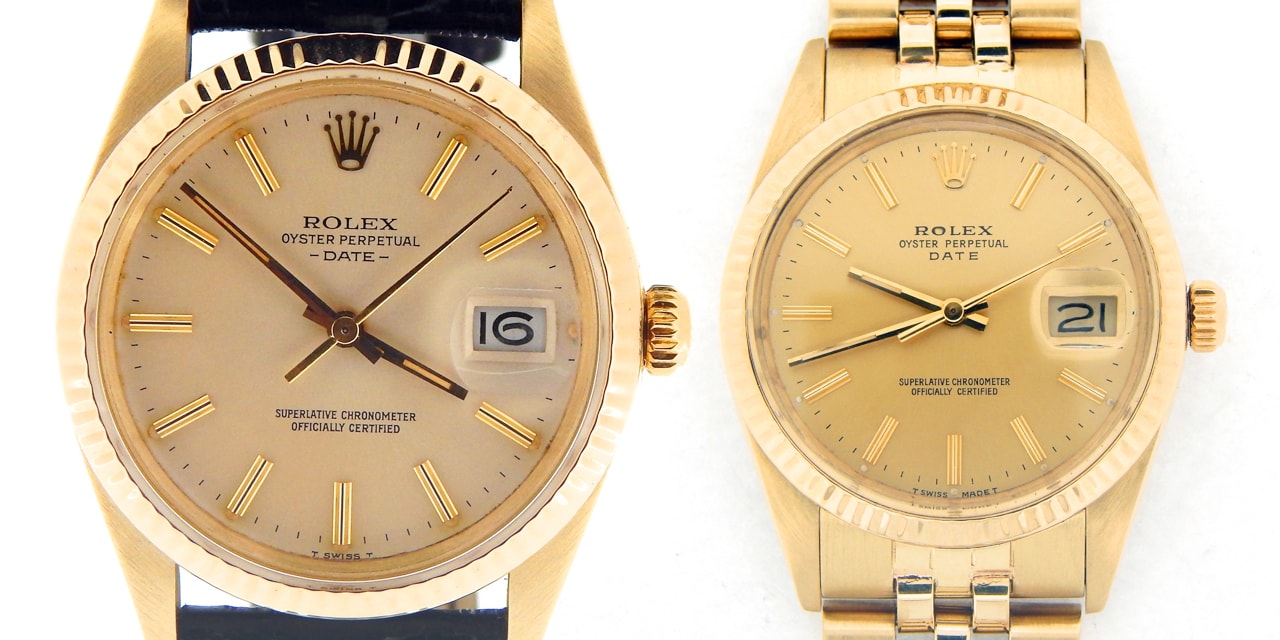The Rolex Metals Series: 14K Gold
Gold has been used in watchmaking for as long as watches have been made.
In fact, its role in horology far predates the invention of the clock, with the precious metal found in the very earliest time measurement devices of various ancient cultures—the sundials and clepsydras of China and Babylonia.
Prized for both its visual beauty as well as its resistance to tarnishing and corrosion, it offers the perfect mix of aesthetics and functionality. As such, it is not just watch cases which have been forged in gold over the centuries, but also many of the internal workings as well. Its durability and natural antimagnetic qualities have seen it employed to protect base plates, bridges and gears.
Today, Rolex is by far the world’s biggest manufacturer of gold watches, with somewhere in the region of 200,000 of their estimated 1,000,000 annual yield made from one of the three colors they use.
Throughout their history the brand has offered models crafted from various purities of gold, with 9K and 14K prevalent in their more formative years due to cost-effectiveness and certain import laws in several countries. In the modern era, where any Rolex watch, and certainly a gold one, is very much a statement of luxury and achievement, only 18K is deemed good enough.
However it was only in the mid-1970s, when it became legal to sell 18K gold watches in the U.S., that the lesser alloys started to be phased out. You could still buy Rolexes made from 14K as recently as the 1990s.
Below, we will take a look at the company’s use of 14K gold over the years, and the pieces that used it.
What is 14K Gold?
Gold is a particularly soft metal (about a 2.5 on the Mohs scale, just below copper and above zinc and tin).
As such it is rarely used in jewelry making in its purest form, and is even less common for watches. Malleable and yielding by nature, it means even light wear would be likely to result in cases becoming dented and misshapen. In order to add strength, the gold is mixed with other elements to make it more resilient, and it is the addition of these other metals that creates the different colors we are used to seeing.
The purity of the alloy (the percentage of gold in relation to the other metals) is measured in karats. In the case of Rolex’s own 14K, that works out as 58.3% gold, with the rest consisting of either silver and copper for yellow gold, nickel or palladium for white, and copper for red. (The brand’s proprietary 18K Everose, introduced in 2005, includes around 2% platinum to seal in the color).
Since 14K gold contains a higher proportion of the harder metals, it is actually a more durable alloy than the 18K Rolex uses exclusively today. And as there is less gold in the mix, it was also cheaper to produce.
Because of that, 14K is still one of the most popular grades in the modern jewelry industry, with the vast majority of wedding rings in the U.S. formed from it.
Rolex 14K Gold
Pure gold, as it is taken out of the ground, is classified as 24K. As well as being pretty much unworkable as a watchmaking material, it also doesn’t have an especially pleasing color. The aesthetics come later, when it is mixed with the other components in their various ratios. It is easier to think of these amalgams in terms of ‘parts of the whole’. So, 14K is 14 parts gold out of the total of 24.
However, while 14K isn’t pure gold, it is still considered ‘solid’ gold in the U.S. In fact, anything above 10K (10 parts out of 24) can be described as solid gold.
Between 1934 and 1974, 14K gold was actually the purest that could be sold in America, which is why the vintage watch market here is so well stocked with them.
The end of that federal legislation coincided nicely with the change in marketing strategy the quartz crisis had forced on Rolex. The influx of cheap and extremely accurate electronic watches coming in from Japan effectively decimated the traditional Swiss industry, bankrupting close to two-thirds of them in less than a decade. Although they fared better than most, Rolex were still compelled to start trading on other the qualities inherent in their products, such as heritage, craftsmanship and, most of all, aspiration. Rather than simply making the best mechanical timepieces in the business, they were now the ultimate lifestyle brand. Going hand-in-hand with that was a commitment to using only the very finest materials, and so 14K gold was slowly replaced across the board with 18K.
Rolex’s 14K Gold Watches
Below we list the 14K gold watches Rolex have made over the years, along with their dates of production.
The Date
| Ref. | Year |
|---|---|
| 6534 | 1950-1962 |
| 1500 | 1962-1983 |
| 1501 | 1962-1983 |
| 1503 | 1962-1983 |
| 15053 | 1983-1988 |
| 15037 | 1983-1988 |
The Datejust
| Ref. | Year |
|---|---|
| 1601/7 | 1959-1977 |
| 16013 | 1977-1988 |
The Oyster Perpetual
| Ref. | Year |
|---|---|
| 3131 | 1936-1955 |
| 3132 | 1936-1955 |
| 6551 | 1960-1984 |
| 6564 | 1960-1984 |
| 6567 | 1960-1984 |
| 6590 | 1960-1984 |
| 1005 | 1959-1988 |
| 1008 | 1959-1988 |
| 1011 | 1959-1988 |
The Daytona
| Ref. | Year |
|---|---|
| 6238 | 1960-1967 (pre-Daytona) |
| 6239 | 1963-1969 |
| 6241 | 1965-1969 |
| 6262 | 1969-1970 |
| 6264 | 1969-1972 |
| 6263 | 1971-1988 |
| 6265 | 1971-1988 |
— Featured Photo Credit: BeckerTime’s Archive.





